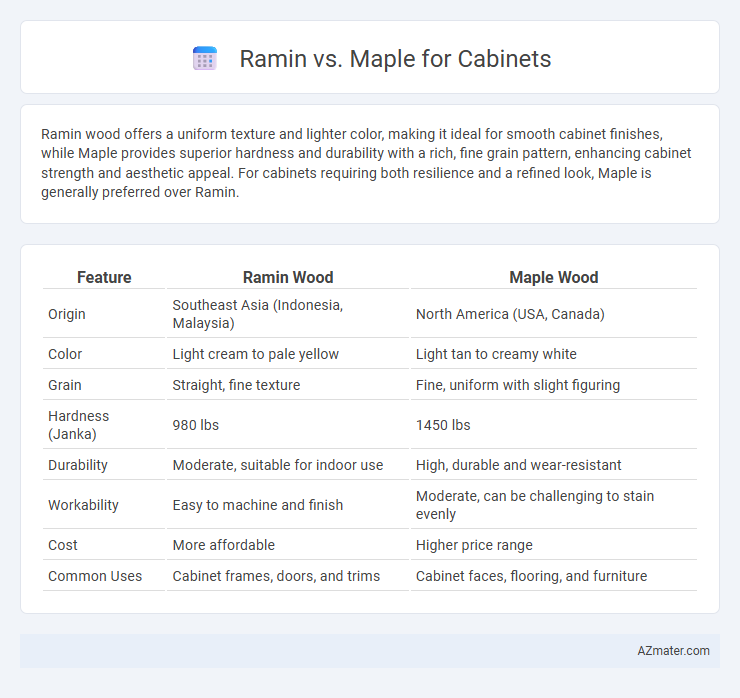Ramin wood offers a uniform texture and lighter color, making it ideal for smooth cabinet finishes, while Maple provides superior hardness and durability with a rich, fine grain pattern, enhancing cabinet strength and aesthetic appeal. For cabinets requiring both resilience and a refined look, Maple is generally preferred over Ramin.
Table of Comparison
| Feature | Ramin Wood | Maple Wood |
|---|---|---|
| Origin | Southeast Asia (Indonesia, Malaysia) | North America (USA, Canada) |
| Color | Light cream to pale yellow | Light tan to creamy white |
| Grain | Straight, fine texture | Fine, uniform with slight figuring |
| Hardness (Janka) | 980 lbs | 1450 lbs |
| Durability | Moderate, suitable for indoor use | High, durable and wear-resistant |
| Workability | Easy to machine and finish | Moderate, can be challenging to stain evenly |
| Cost | More affordable | Higher price range |
| Common Uses | Cabinet frames, doors, and trims | Cabinet faces, flooring, and furniture |
Introduction to Ramin and Maple Woods
Ramin wood, sourced primarily from the Shorea genus in Southeast Asia, is known for its light color, fine texture, and durability, making it a popular choice for cabinetry and indoor furniture. Maple wood, derived mainly from the Acer genus native to North America, offers a smooth grain, hardness, and resistance to wear, favored for its aesthetic appeal and strength in cabinet making. Both woods provide distinct advantages: Ramin for its workability and uniform appearance, and Maple for its hardness and light, creamy tones that enhance cabinetry designs.
Physical Characteristics: Ramin vs Maple
Ramin wood exhibits a pale yellow to light brown color with a fine, uniform texture and straight grain, making it smooth and easy to work with for cabinetry. Maple is typically light cream to nearly white with a slightly reddish hue, featuring a fine, closed grain that produces a smooth, hard surface highly resistant to scratches. Both woods offer durability, but Maple's greater density and hardness provide superior resistance to dents and wear, ideal for heavily used cabinets.
Durability and Strength Comparison
Ramin wood, known for its fine texture and moderate hardness, offers good durability but is less dense compared to Maple, which is highly valued for its exceptional strength and resistance to wear. Maple's tighter grain structure and higher Janka hardness rating make it ideal for cabinetry requiring long-lasting durability under frequent use. While Ramin cabinet components perform adequately in lower-traffic areas, Maple significantly outperforms in structural integrity and resistance to dents or impact, ensuring a robust, durable finish.
Aesthetic Appeal and Grain Patterns
Ramin wood offers a fine, uniform grain with a pale yellow to light brown color that enhances cabinet aesthetics through its smooth texture and subtle elegance. In contrast, Maple features a tight, consistent grain with cream to light reddish-brown hues, providing a versatile and classic look favored in cabinetry for its ability to accept stains and finishes well. Both woods excel in aesthetic appeal, but Ramin's delicate grain lends a softer, more refined appearance, while Maple's pronounced figure offers a more traditional, robust visual impact.
Cost and Availability
Ramin wood is generally more affordable than maple, making it a popular choice for budget-conscious cabinet projects. Maple is widely available and prized for its durability and fine grain, but its higher price reflects its premium quality. Availability of ramin can be limited outside Southeast Asia, whereas maple is readily accessible across North America and Europe.
Workability and Ease of Fabrication
Ramin wood offers superior workability due to its uniform texture and fine grain, making it easier to machine and shape with minimal splintering, ideal for detailed cabinet components. Maple, known for its hardness and density, requires sharper tools and more effort during fabrication but provides excellent durability and a smooth finish when properly worked. Both woods allow for precise joinery, but Ramin's softness reduces tool wear and speeds up production, while Maple's robustness enhances the cabinet's longevity.
Environmental Impact and Sustainability
Ramin wood, sourced primarily from Southeast Asia, faces significant environmental concerns due to deforestation and habitat loss, making its sustainability questionable without certified harvest practices. Maple, often harvested from North American forests managed under sustainable forestry programs, offers a lower environmental impact when sourced from FSC-certified suppliers. Choosing maple for cabinetry reduces carbon footprint risks and supports responsible forest management compared to the more ecologically sensitive Ramin.
Maintenance and Longevity
Ramin wood, known for its fine, even texture and moderate durability, requires regular sealing and maintenance to prevent moisture damage in cabinets. Maple is a harder, denser wood that offers superior resistance to scratches and wear, making it a low-maintenance choice ideal for long-lasting cabinetry. Cabinets made from maple typically exhibit greater longevity due to their strength and natural resistance to dents and warping compared to ramin.
Best Use Cases for Cabinets
Ramin wood is highly valued for cabinet construction due to its smooth texture and fine grain, making it ideal for intricate carvings and detailed moldings in high-end custom cabinetry. Maple stands out for its hardness and durability, which provides excellent resistance to dents and scratches, making it perfect for kitchen cabinets and heavily used storage solutions. Both woods offer versatility, but Ramin excels in decorative applications while Maple is preferred for functional, heavy-use cabinets.
Making the Right Choice: Ramin or Maple?
Ramin wood offers a light, even texture and smooth finish ideal for intricate cabinet details, while Maple provides superior hardness and durability, making it better for high-traffic kitchen areas. When choosing between Ramin and Maple for cabinets, consider Maple's strong resistance to wear and its ability to take stains and finishes evenly, resulting in a versatile, long-lasting surface. Ramin is best suited for aesthetic appeal and affordability, whereas Maple excels in strength and longevity, ensuring cabinets withstand daily use without compromising on style.

Infographic: Ramin vs Maple for Cabinet
 azmater.com
azmater.com